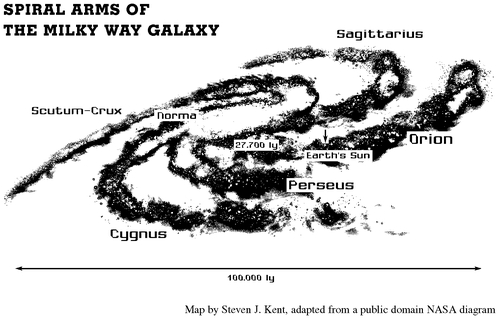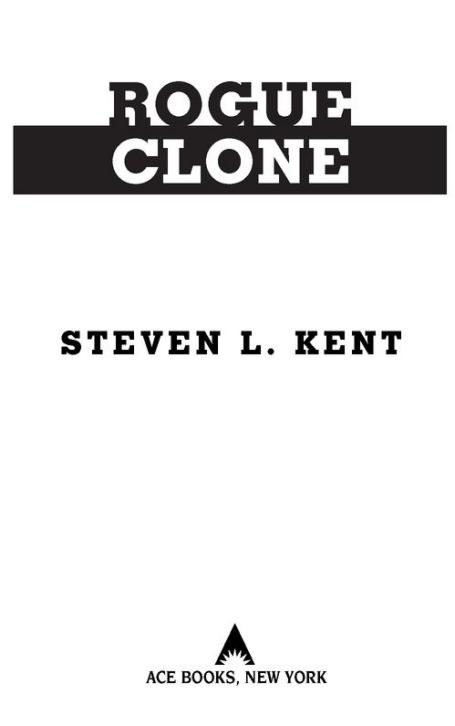Rogue clone (48 page)
Authors: Steven L. Kent
Tags: #Science fiction, #General, #Fiction, #Fiction - Science Fiction, #Science Fiction - General, #High Tech, #Space Opera, #Adventure, #Life on other planets, #Science Fiction And Fantasy, #War & Military, #Soldiers, #Cloning, #Human cloning

Penguin Books (South Africa) (Pty.) Ltd., 24 Sturdee Avenue, Rosebank, Johannesburg 2196, South Africa
Penguin Books Ltd., Registered Offices: 80 Strand, London WC2R 0RL, England
This is a work of fiction. Names, characters, places, and incidents either are the product of the author’s imagination or are used fictitiously, and any resemblance to actual persons, living or dead, business establishments, events, or locales is entirely coincidental. The publisher does not have any control over and does not assume any responsibility for author or third-party websites or their content.
An Ace Book / published by arrangement with the author
Ace mass-market edition / October 2006
Copyright © 2006 by Steven L. Kent.
All rights reserved.
No part of this book may be reproduced, scanned, or distributed in any printed or electronic form without
permission. Please do not participate in or encourage piracy of copyrighted materials in violation of the author’s rights.
Purchase only authorized editions.
For information address: The Berkley Publishing Group,
a division of Penguin Group (USA) Inc.,
375 Hudson Street, New York, New York 10014.
eISBN : 978-1-436-28310-6
ACE
Ace Books are published by The Berkley Publishing Group,
a division of Penguin Group (USA) Inc.,
375 Hudson Street, New York, New York 10014.
ACE and the “A” design are trademarks belonging to Penguin Group (USA) Inc.
This book is dedicated to pioneering audio book reader Frank Muller, whose recording career was cut short by a motorcycle accident in 2001.
Most people think of writers when they hear the term “literary figure,” but few authors have had as great an impact on my life as Frank Muller. His incredible talent has brought the works of Elmore Leonard, Herman Melville, Stephen King, John Grisham, Charles Dickens and many other great writers to life for me, and I am eternally grateful.
Mr. Muller, your voice is always with me. Thank you.
Fireflies dance in the heat of
Hound dogs bay at the moon
My ship leaves in the midnight
can’t say I’ll be back too soon
—Aerosmith “Seasons of Wither”
THE FUEL OF VIOLENCE
Every clone, including me, believed he was natural-born. We grew up in orphanages, surrounded by 36,000 identical beings. Each clone believed that he was the lone natural-born on the premises. They were programmed to see themselves as having blond hair and blue eyes. When three clones shared one mirror, they all saw themselves with blond hair and blue eyes, while recognizing the brown hair and brown eyes of their comrades.
But I did not see myself as having blond hair or blue eyes. I was a Liberator-Class clone. Other clone soldiers were built to be strong, patriotic, and ignorant of their origins. They were boy scouts and a little gland inside their brain would release a deadly hormone if they ever accepted the unnatural nature of their origin.
I was built to be fast, ill-natured, utterly deadly, and addicted to violence. I did not have the death reflex built into my brain. Instead, I had a gland that released an addictive combination of endorphins and adrenaline into my blood to clear my head during combat . . .
Praise for
The Clone Republic
“A solid debut. Harris is an honest, engaging protagonist and thoughtful narrator, and Kent’s clean, transparent prose fits well with both the main character and the story’s themes . . . Kent is a skillful storyteller, and the book entertains throughout.”—
Science Fiction Weekly
“The first sentence gets you immediately . . . From there, the action begins fast and furious with dark

musings, lavish battle scenes, and complex characterizations . . .
The Clone Republic
feature[s] taut writing and a truly imaginative plot full of introspection and philosophizing.”
—
Village Voice
Earthdate: 2512 A.D.
“It was the best of times, it was the worst of times . . .” Charles Dickens laid claim to those words more than 650 years too soon. You want the best of times? The best of times is when you control known space. You’ve explored the galaxy from corner to corner, you haven’t found any opposition, so you claim the whole thing for yourself.
You want the worst of times? It’s when you’ve been running the galaxy for four centuries, and all of a sudden you find your Republic crumbling from within.
The battle facing mankind involved either two sides or four sides, depending on how you interpreted it. There were no true allies in this little battle royale, though the three weaker nations pooled their resources to pull down the fourth.
On the one hand, you had the Unified Authority with its Earth-bound legislatures, its intergalactic highway, and its enormous military complex. The ever-evolving successor to the old United States, the Unified Authority began its expansion in the twenty-first century. First it became a global empire and then a galactic republic. The U.A. colonized the six arms of the Milky Way, creating a cosmopolitan society that superseded race and ethnicity. The galactic territories became a true melting pot as 180 new worlds opened up over the next 400 years.
The Unified Authority accomplished all of that expansion off the back of an almost all-clone military. By the beginning of the twenty-second century, U.A. clone labs began churning out over 100,000 cloned soldiers per year. By 2200 A.D., clone production was up to over one million per year. That sounds like a lot, but it’s not as much as you’d think when you are conquering and colonizing a galaxy that is 100,000 light years in diameter.
The first real challenge to the Unified Authority’s hold on the galaxy came in the year 2468 when a scientific expedition exploring the inner curve of the Norma Arm vanished. Afraid that they had located a hostile race, the U.A. Senate authorized the construction of a super fleet of battleships—the Galactic Central Fleet. Senator Morgan Atkins, the most powerful politician of his time, oversaw the creation of the fleet and traveled with it on its first patrol of the Norma Arm. Neither Atkins nor the fleet returned from that first patrol.
These were desperate times, but a few well-placed politicians had a plan of their own. Working with the U.A. Navy, they manufactured a breed of specially designed clones called “Liberators” which they sent into the Galactic Eye, the spot in the center of the galaxy where the six arms merge. Liberators were designed to be fast, intelligent, and dangerous. Their physiology included a gland that introduced a combination of endorphins and adrenaline into their blood during combat. Once they entered the Galactic Eye, the Liberators discovered that Atkins and a large group of followers were behind the disappearances. Had he known about the Liberator project, Atkins might have prepared for an invasion. Instead, the Liberators caught him entirely off guard. They overwhelmed the renegade base, but Morgan Atkins and his followers escaped in their stolen Fleet. Sometime during the next three years, colonies of religious fanatics calling themselves “Morgan Atkins Believers” began appearing throughout the galaxy. The Mogats, the common name for the Morgan Atkins religious movement, preached individualism and independence from Earth government. As the 180 established worlds became more self-sufficient, the Mogat movement gained converts. A census taken in 2498 A.D. found approximately five million Morgan Atkins Believers. According to the 2508 census, more than 200 million people identified themselves as Mogats. Discovering that more than 200 million people had joined a potentially hostile religious movement, Congress woke up. New laws were drawn and the Atkins movement was loosely labeled subversive.
In 2510, four of the galactic arms declared independence from the Unified Authority and the civil war began. The Cygnus, Perseus, Norma, and Scutum-Crux arms formed an organization called the Confederate Arms Treaty Organization. Only the Orion Arm, Earth’s home arm, and the Sagittarius Arm remained loyal to the Unified Authority.
The Morgan Atkins Believers and the Confederate Arms formed an unsteady alliance. The Confederate Arms had an enormous population and large armies, but no fleet to move troops and defend planets. The Mogats had the Galactic Central Fleet, but they lacked the manpower to pilot their ships. A third partner was suspected of joining the Mogat/ Confederate alliance—the Japanese people of Ezer Kri. Ezer Kri was a more-or-less law-abiding planet in the Scutum-Crux Arm with a large population of people of Japanese ancestry. As the civil war began, the government of Ezer Kri came into conflict with the Unified Authority. I was in the U.A. Marines at the time. When the Marines invaded Ezer Kri, the Mogat colonists who had settled on that planet fought a guerilla campaign. Our invasion turned into an occupation and the Japanese population vanished from the planet. No one knew what happened to them. Then the war broke out. The Confederate Arms and Mogats launched their insurrection. According to our best intelligence, the Japanese population of Ezer Kri signed on with them. Even with the Japanese on their side, the Mogats and Confederate Arms did not seem to pose much of a threat. As I said before, “It was the best of times, it was the worst of times . . .”
MURDER
THE INVESTIGATION
WAR
REDEMPTION
Table of Contents
Title Page
Copyright Page
Dedication
Acknowledgements
Epigraph
Part I - MURDER
CHAPTER TWO
CHAPTER THREE
CHAPTER FIVE
CHAPTER SIX
CHAPTER EIGHT
CHAPTER NINE
CHAPTER ELEVEN
CHAPTER TWELVE
CHAPTER FOURTEEN
Part II - THE INVESTIGATION
CHAPTER SIXTEEN
CHAPTER SEVENTEEN
CHAPTER NINETEEN
CHAPTER TWENTY
CHAPTER TWENTY-TWO
Part III - WAR
CHAPTER TWENTY-FOUR
CHAPTER TWENTY-SIX
CHAPTER TWENTY-EIGHT
CHAPTER THIRTY
CHAPTER THIRTY-ONE
CHAPTER THIRTY-THREE
CHAPTER THIRTY-FIVE
CHAPTER THIRTY-SEVEN
Part IV - REDEMPTION
CHAPTER THIRTY-NINE
CHAPTER FORTY-ONE
CHAPTER FORTY-THREE
CHAPTER FORTY-FIVE
CHAPTER FORTY-SEVEN
CHAPTER FORTY-NINE
CHAPTER FIFTY-ONE
CHAPTER FIFTY-THREE
THE ULTIMATE IN SCIENCE FICTION AND FANTASY!

